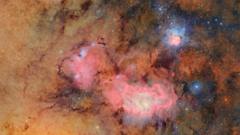Recent analyses by astronomers have refuted earlier claims of detecting signs of life on the exoplanet K2-18b, emphasizing the complexities of exoplanet observation and the challenges of studying distant worlds.
New Evidence Challenges Life Sign Discovery on Exoplanet K2-18b

New Evidence Challenges Life Sign Discovery on Exoplanet K2-18b
After initial claims of possible life, independent research casts doubt on the findings regarding the distant exoplanet K2-18b.
In April, excitement surged within the scientific community when astronomers tentatively suggested signs of life on K2-18b, a distant exoplanet located 120 light-years away. This assertion ignited a wave of global curiosity about extraterrestrial life. However, the excitement quickly turned into skepticism as three independent analyses emerged, delivering a unanimous verdict: the initial claims lack sufficient evidence.
Luis Welbanks, an astronomer at Arizona State University involved in one of the new studies, summarized the consensus simply: "The claim just absolutely vanishes." This robust scrutiny reflects not only a focused effort on the specific claims regarding K2-18b but also highlights the inherent difficulties faced by researchers trying to detect life beyond our solar system.
The real crux of the issue lies in the challenging nature of observing exoplanets at such extreme distances. In contrast to closer celestial bodies like Jupiter, K2-18b’s great distance renders it imperceptible to the human eye and conventional telescopes. Astronomers have developed various innovative techniques to study these distant worlds, such as examining the gravitational influence they exert on nearby stars or detecting subtle shifts in starlight as planets transit in front of their host stars.
Notably, groundbreaking instruments like the James Webb Space Telescope have allowed astronomers to discern faint patterns in starlight, enhancing our understanding of exoplanet atmospheres. In previous studies, such as the observation of GJ 1214b, intriguing hints about planetary atmospheres were inferred through careful analysis of light absorption during transits. However, the excitement surrounding K2-18b now serves as a cautionary tale about the early claims surrounding potential signs of life, reminding us of the ongoing complexities in astronomical research.
Luis Welbanks, an astronomer at Arizona State University involved in one of the new studies, summarized the consensus simply: "The claim just absolutely vanishes." This robust scrutiny reflects not only a focused effort on the specific claims regarding K2-18b but also highlights the inherent difficulties faced by researchers trying to detect life beyond our solar system.
The real crux of the issue lies in the challenging nature of observing exoplanets at such extreme distances. In contrast to closer celestial bodies like Jupiter, K2-18b’s great distance renders it imperceptible to the human eye and conventional telescopes. Astronomers have developed various innovative techniques to study these distant worlds, such as examining the gravitational influence they exert on nearby stars or detecting subtle shifts in starlight as planets transit in front of their host stars.
Notably, groundbreaking instruments like the James Webb Space Telescope have allowed astronomers to discern faint patterns in starlight, enhancing our understanding of exoplanet atmospheres. In previous studies, such as the observation of GJ 1214b, intriguing hints about planetary atmospheres were inferred through careful analysis of light absorption during transits. However, the excitement surrounding K2-18b now serves as a cautionary tale about the early claims surrounding potential signs of life, reminding us of the ongoing complexities in astronomical research.






















